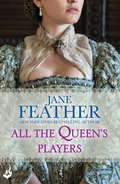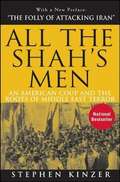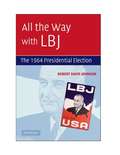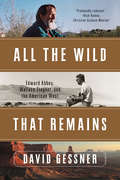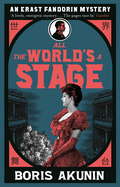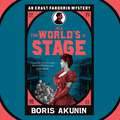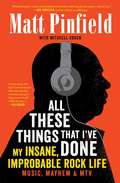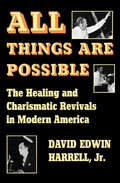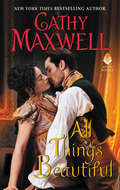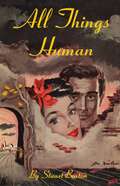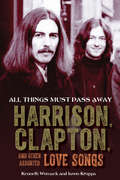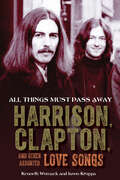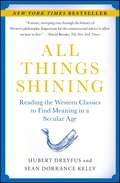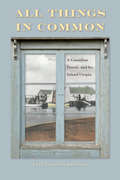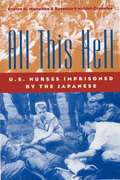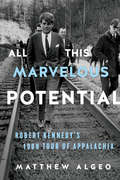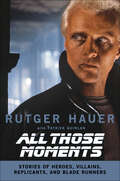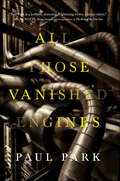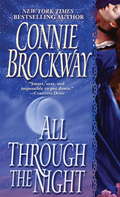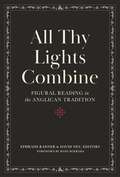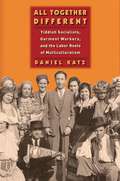- Table View
- List View
All The Light There Was: A Novel
by Nancy KricorianAll the Light There Was is the story of an Armenian family’s struggle to survive the Nazi occupation of Paris in the 1940s—a lyrical, finely wrought tale of loyalty, love, and the many faces of resistance.On the day the Nazis march down the rue de Belleville, fourteen-year-old Maral Pegorian is living with her family in Paris; like many other Armenians who survived the genocide in their homeland, they have come to Paris to build a new life. The adults immediately set about gathering food and provisions, bracing for the deprivation they know all too well. But the children—Maral, her brother Missak, and their close friend Zaven—are spurred to action of another sort, finding secret and not-so-secret ways to resist their oppressors. Only when Zaven flees with his brother Barkev to avoid conscription does Maral realize that the Occupation is not simply a temporary outrage to be endured. After many fraught months, just one brother returns, changing the contours of Maral’s world completely. Like Tatiana de Rosnay’s Sarah’s Key and Jenna Blum’s Those Who Save Us, All the Light There Was is an unforgettable portrait of lives caught in the crosswinds of history.
All The Queen's Players
by Jane FeatherNew York Times bestselling author Jane Feather conspires with history to tell this dazzling story about two very real, very wily queens - and one impassioned young woman whose life they change forever.At Queen Elizabeth's palace, intrigue abounds. And when a naive girl with a gift for keen observation enters the court, she can hardly imagine the role she will play in bringing England - indeed, the whole of Europe - to the brink of war. Nor can she foresee her own journey to the brink of ecstasy and beyond...When she becomes a junior lady of Queen Elizabeth's bedchamber, Rosamund is instructed by her cousin, the brilliant and devious secretary of state Sir Francis Walsingham, to record everything she observes. Her promised reward: a chance at a good marriage. And then Rosamund meets Will Creighton - a persuasive courtier, poet, and would-be playwright who is the embodiment of an unsuitable match. The unsanctioned relationship draws the wrath of Elizabeth, and Rosamund is sent in disgrace to a remote castle that holds Elizabeth's cousin Mary Stuart, the imprisoned Queen of Scots. Here, Walsingham expects Rosamund to uncover proof of a plot against Elizabeth. But surely, nothing good can come of putting an artless girl in such close proximity to so many seductive players and deceptive games. Unless, of course, Rosamund can discover an affinity for passion and intrigue herself... For more of Jane Feather's signature romance check out the Blackwater Brides Trilogy - where three dashing brothers embark on a most im-proper quest - or follow the adventures to three intrepid young ladies as they become embroiled in the political intrigue of Regency-era London and fall irreversibly in love in the Cavendish Square Trilogy.
All The Shah's Men: An American Coup And The Roots Of Middle East Terror
by Stephen KinzerWith a thrilling narrative that sheds much light on recent events, this national bestseller brings to life the 1953 CIA coup in Iran that ousted the country's elected prime minister, ushered in a quarter-century of brutal rule under the Shah, and stimulated the rise of Islamic fundamentalism and anti-Americanism in the Middle East. Selected as one of the best books of the year by the Washington Post and The Economist, it now features a new preface by the author on the folly of attacking Iran.
All The Way With Lbj: The 1964 Presidential Election
by Robert David JohnsonAll the Way with LBJ mines an extraordinarily rich but underutilized source - the full range of LBJ tapes - to analyze the 1964 presidential campaign and the political culture of the mid-1960s. The president achieved a smashing victory over a divided Republican Party, which initially considered Henry Cabot Lodge II, then US ambassador to South Vietnam, before nominating Barry Goldwater, who used many of the themes that later worked for Republicans - a Southern strategy, portraying the Democrats as soft on defence, raising issues such as crime and personal ethics. Johnson countered with what he called a 'frontlash' strategy, appealing to moderate and liberal GOP suburbanites, but he failed to create a new, permanent Democratic majority for the post-civil rights era. The work's themes - the impact of race on the political process, the question of politicians' personal and political ethics, and the tensions between politics and public policy - continue to resonate.
All The Wild That Remains: Edward Abbey, Wallace Stegner, and the American West
by David GessnerAn homage to the West and to two great writers who set the standard for all who celebrate and defend it. Archetypal wild man Edward Abbey and proper, dedicated Wallace Stegner left their footprints all over the western landscape. Now, award-winning nature writer David Gessner follows the ghosts of these two remarkable writer-environmentalists from Stegner's birthplace in Saskatchewan to the site of Abbey's pilgrimages to Arches National Park in Utah, braiding their stories and asking how they speak to the lives of all those who care about the West. These two great westerners had very different ideas about what it meant to love the land and try to care for it, and they did so in distinctly different styles. Boozy, lustful, and irascible, Abbey was best known as the author of the novel The Monkey Wrench Gang (and also of the classic nature memoir Desert Solitaire), famous for spawning the idea of guerrilla actions--known to admirers as "monkeywrenching" and to law enforcement as domestic terrorism--to disrupt commercial exploitation of western lands. By contrast, Stegner, a buttoned-down, disciplined, faithful family man and devoted professor of creative writing, dedicated himself to working through the system to protect western sites such as Dinosaur National Monument in Colorado. In a region beset by droughts and fires, by fracking and drilling, and by an ever-growing population that seems to be in the process of loving the West to death, Gessner asks: how might these two farseeing environmental thinkers have responded to the crisis? Gessner takes us on an inspiring, entertaining journey as he renews his own commitment to cultivating a meaningful relationship with the wild, confronting American overconsumption, and fighting environmental injustice--all while reawakening the thrill of the words of his two great heroes.
All The World's A Stage: Erast Fandorin 11 (Erast Fandorin Mysteries)
by Boris AkuninTHE 11TH BOOK IN THE BESTSELLING ERAST FANDORIN MYSTERIES SERIESEBRD LITERATURE PRIZE FINALIST'This is Akunin on characteristic form... the pages race by' GuardianEliza Altairsky-Lointaine is the toast of Moscow society, a beautiful actress in an infamous theatre troupe. Her love life is as colourful as the parts she plays. She is the estranged wife of a descendant of Genghis Khan. And her ex-husband has threatened to kill anyone who courts her.He appears to be making good on his promise.Fandorin is contacted by concerned friend - the widowed wife of Chekhov - who asks him to investigate an alarming incident involving Eliza. But when he watches Eliza on stage for the first time, he falls desperately in love . . . Can he solve the case - and win over Eliza - without attracting the attentions of the murderer he is trying to find?What readers are saying about the Erast Fandorin Mysteries:'I loved how it consumes you, making you believe that you're indeed living in different era' Olga on Goodreads (five stars)'A delightful mystery/adventure! There's a dark twist at the end that has me anxious to continue in this series' Neil on Goodreads (five stars)'These books are a fun, riotous read that you don't want to put down until you've completed each and every one of them' Jill on Goodreads (five stars)'Every sentence is a delight to read... I am almost feeling bereft now that I have once more run out of English copies of Akunin's work.' Kate on Goodreads (five stars)A page-turning delight perfect for fans of Sherlock Holmes, Hercule Poirot and the Russian literary greats. Shortlisted for the inaugural EBDR Literature Prize.
All The World's A Stage: Erast Fandorin 11 (Erast Fandorin Mysteries)
by Boris AkuninEliza Altairsky-Lointaine is the toast of Moscow society, a beautiful actress in an infamous theatre troupe. Her love life is as colourful as the parts she plays. She is the estranged wife of a descendant of Genghis Khan. And her ex-husband has threatened to kill anyone who courts her.He appears to be making good on his promise.Fandorin is contacted by concerned friend - the widowed wife of Chekhov - who asks him to investigate an alarming incident involving Eliza. But when he watches Eliza on stage for the first time, he falls desperately in love . . . Can he solve the case - and win over Eliza - without attracting the attentions of the murderer he is trying to find?Read by Jonathan Coote(p) Orion Publishing Group 2017
All These Bodies
by Kendare Blake* Indie Next List Pick * Indie Bestseller *Sixteen bloodless bodies. Two teenagers. One impossible explanation. In this edge-of-your-seat mystery from #1 New York Times bestselling author Kendare Blake, the truth is as hard to believe as it is to find.Summer 1958. A gruesome killer plagues the Midwest, leaving behind a trail of bodies completely drained of blood. Michael Jensen, an aspiring journalist whose father happens to be the town sheriff, never imagined that the Bloodless Murders would come to his backyard. Not until the night the Carlson family was found murdered in their home. Marie Catherine Hale, a diminutive fifteen-year-old, was discovered at the scene—covered in blood. She is the sole suspect in custody.Michael didn’t think that he would be part of the investigation, but he is pulled in when Marie decides that he is the only one she will confess to. As Marie recounts her version of the story, it falls to Michael to find the truth: What really happened the night that the Carlsons were killed? And how did one girl wind up in the middle of all these bodies?
All These Things That I've Done: My Insane, Improbable Rock Life
by Mitchell Cohen Matt Pinfield"The most trusted opinion in rock music" (Billy Corgan, The Smashing Pumpkins), Matt Pinfield offers the ultimate music fan's memoir, a chronicle of the songs and artists that inspired his improbable career alongside some of the all-time greats, from The Beatles to KISS to U2 to The Killers.Matt Pinfield is the ultimate music fan. He's the guy who knows every song, artist, and musical riff ever recorded, down to the most obscure band's B-side single on its vinyl-only EP import. As a child, music helped Pinfield make sense of the world. Later, as a teenager, Pinfield would approach his music idols after concerts and explain why he loved their music. As an adult, rock music inspired his career, fueled relationships, and, at times, became a life raft. In this expansive, no-holds-barred memoir Pinfield traces his lifelong music obsession--from the heavy metal that infused his teenage years, to his first encounters with legends like Lou Reed and The Ramones and how, through his post-MTV years, he played a major role in bringing nineties alt rock mainstream. Over his long career Pinfield has interviewed everyone from Paul McCartney to Nirvana to Jay-Z, earning the trust and admiration of artists and fans alike. Now, for the first time, Pinfield shares his five decades of stories from the front lines of rock and roll, exploring how, with nothing more than passion and moxy, he became a sought-after reporter, unlikely celebrity, and the last word in popular music. Featuring a rousing collection of best-of lists, favorite tracks, and artist profiles, All These Things That I've Done explains how a born outsider wound up in the inner circle.
All Things Are Possible: The Healing and Charismatic Revivals in Modern America (Encounters: Explorations in Folklore and Ethnomusicology)
by David Edwin Harrell Jr.&“The first book to tell the story of the enterprisers who have personal followings . . . a missing link in the chain of American religious movements.&”—Martin E. Marty, author of October 31, 1517: Martin Luther and the Day that Changed the World Written by a Professor Emeritus at Auburn University, this is the first objective history of the great revivals that swept the country after World War II. It tells the story of the victories and defeats of such giants of the revival as William Branham, Oral Roberts, Jack Coe, T. L. Osborn, and A. A. Allen. It also tells of the powerful evangelists who carried on the revival, including Robert Schambach and Morris Cerullo. Those who lived through the great revivals of the 1950s and 1960s will be thrilled to read about those exciting days, and those interested in the religious history of the United States need to read this book to see what has led us up to this present moment in time. &“Harrell has obviously attended countless rallies, read sheafs of literature, and personally interviewed many of the principals. He . . . tell[s] the story in a largely biographical format. This makes for lively reading.&”—The New York Times Book Review &“A book about healing revivalists that takes them seriously and treats them fairly.&”—Journal of Southern History &“Will be a definitive work for some years to come.&”—Reviews in American History &“Will attract readers interested in the reasons behind the various fat and lean periods among revivalists.&”—Publishers Weekly &“Harrell&’s book will doubtless be the definitive work on the subject for a long while—who else will wade through Healing Waters and Miracle Magazine with such fastidious care?&”—Kirkus Reviews
All Things Beautiful
by Cathy MaxwellLady Julia Markham was the toast of London Society -- until an ill-advised attempted elopement ended in betrayal and left her good name in tatters. Now ruined, penniless, and desperate, she has agreed to wed the magnetic and possibly dangerous Brader Wolf. A dashing, phenomenally successful self-made businessman, Brader wants this union to help gain him entry into the drawing rooms of the aristocracy, nothing more. Julia, however, is a woman of rare passion and daring, irresistibly drawn to this enigmatic, infuriating man, and no mere marriage of mutual convenience will do. But how far will the spirited beauty have to go to satisfy a heart that will settle for no less than the love of a lifetime?
All Things Georgian: Tales from the Long Eighteenth Century
by Joanne Major Sarah MurdenExperience life in Britain&’s &“long eighteenth-century&” with this collection of 25 real tales from history by the authors of An Infamous Mistress. Marvel at the Queen&’s Ass, gaze at the celestial heavens through the eyes of the past, and be amazed by the equestrian feats of the Norwich Nymph. Journey to the debauched French court at Versailles, travel to Covent Garden and take your seat in a box at the theatre, and, afterwards, join the mile-high club in a new-fangled hot air balloon. Meet actresses, whores and high-born ladies, politicians, inventors, royalty, and criminals as we travel through the Georgian era in all its glorious and gruesome glory. In roughly chronological order, covering the reign of the four Georges (1714-1830), and set within the framework of the main events of the era, these tales are accompanied by over 100 stunning color illustrations.
All Things Harmless, Useful, and Ornamental: Environmental Transformation through Species Acclimatization, from Colonial Australia to the World (Flows, Migrations, and Exchanges)
by Pete MinardSpecies acclimatization--the organized introduction of organisms to a new region--is much maligned in the present day. However, colonization depended on moving people, plants, and animals from place to place, and in centuries past, scientists, landowners, and philanthropists formed acclimatization societies to study local species and conditions, form networks of supporters, and exchange supposedly useful local and exotic organisms across the globe. Pete Minard tells the story of this movement, arguing that the colonies, not the imperial centers, led the movement for species acclimatization. Far from attempting to re-create London or Paris, settlers sought to combine plants and animals to correct earlier environmental damage and to populate forests, farms, and streams to make them healthier and more productive. By focusing particularly on the Australian colony of Victoria, Minard reveals a global network of would-be acclimatizers, from Britain and France to Russia and the United States. Although the movement was short-lived, the long reach of nineteenth-century acclimatization societies continues to be felt today, from choked waterways to the uncontrollable expansion of European pests in former colonies.
All Things Human
by Stuart BentonHere is a remarkable vintage tour-de-force of the Fifties, in which Stuart Benton explores the range of human experience from the sublime to the exotically degrading.Marriage, illicit love, the uneasy relationship between children and parents, business success and failure, a trial for murder, a descent into the underworld of society, and later ascent to the delights of a swiftly-moving, jaded society set—all these can be found in the fabric of All Things Human.John Stuart Kent is a millionaire banker and aesthete, living out the Indian Summer of his life as the shape of his future is altered by five extraordinary women:Helen, his young wife, a resentful Galatea whose pathological jealousy cools their relationship.Sylvia, a fascinating and magnanimous Wagnerian singer, with flaming red hair and a fresh attitude toward love.Aimee, a courtesan, par excellence.Edda, Kent&’s secretary, sweet, young and unashamed who fumbles into scandalous catastrophe.Ivy, a sophisticate of enormous wealth and esoteric accomplishments.John Stuart Kent endures a Faust-like descent to a modern, mechanized Hell, experiencing all the humiliations and betrayals of modern society and its strange criminal procedures on his way. In the fight for his good name and his liberty, Kent must use all of his charm and wit, and enlist the help of a few friends, or he could be stuck in the abyss of the criminal system forever.
All Things Must Pass Away: Harrison, Clapton, and Other Assorted Love Songs
by Kenneth Womack Jason Kruppa, Kenneth Womack Jason KruppaGeorge Harrison and Eric Clapton embarked upon a singular personal and creative friendship that impacted rock's unfolding future in resounding and far-reaching ways. All Things Must Pass Away: George Harrison, Eric Clapton, and Other Assorted Love Songs will trace the emergence of their relationship from 1968 though the early 1970s. In particular, authors Womack and Kruppa devote close attention to the climax of Harrison and Clapton's shared musicianship—the November 1970 releases of All Things Must Pass, Harrison's powerful emancipatory statement in the wake of the Beatles, and Layla and Other Assorted Love Songs, Clapton's impassioned reimagining of his art via Derek and the Dominos, the band that he created from the wreckage of Cream and Blind Faith. All Things Must Pass Away will provide readers with a powerful overview of Harrison and Clapton's relationship, especially in terms of the ways their revolutionary musicianship and songwriting would eclipse rock music as an evolving genre. With All Things Must Pass and Layla, Harrison and Clapton bequeathed twin recorded statements that advanced rock 'n' roll from a windswept 1960s idealism into the edgy new reality of the 1970s.
All Things Must Pass Away: Harrison, Clapton, and Other Assorted Love Songs
by Kenneth Womack and Jason Kruppa"Womack and Kruppa present a thorough history of Harrison and Clapton's songmaking and recording sessions." — BooklistNewly revised and expanded, this paperback edition features exclusive material from the Malcolm Frederick Evans archives and draws on rare material released by the Harrison Estate. A new appendix includes a detailed sessionography and personnel listings for All Things Must Pass, assembled from recently discovered documentation. George Harrison and Eric Clapton embarked upon a singular personal and creative friendship that impacted rock's unfolding future in resounding and far-reaching ways. All Things Must Pass Away: Harrison, Clapton, and Other Assorted Love Songs traces the emergence of their relationship from 1968 though the early 1970s and the making of their career-defining albums, both released in November 1970. Authors Womack and Kruppa devote close attention to the climax of Harrison and Clapton's shared musicianship— the creation of All Things Must Pass, Harrison's powerful emancipatory statement in the wake of the Beatles, and Layla and Other Assorted Love Songs, Clapton's impassioned reimagining of his art via Derek and the Dominos— two records that advanced rock 'n' roll from a windswept 1960s idealism into the wild and expansive new reality of the 1970s. All Things Must Pass Away reveals the foundations of Harrison and Clapton's friendship, focusing on the ways their encouragement and support of each other drove them to produce works that would cast long shadows over the evolving world of rock music.
All Things Shining: Reading the Western Classics to Find Meaning in a Secular Age
by Hubert Dreyfus Sean Dorrance KellyIn unrelenting flow of choices confronts us at nearly every moment of our lives, and yet our culture offers us no clear way to choose. This predicament seems inevitable, but in fact it's quite new. In medieval Europe, God's calling was a grounding force. In ancient Greece, a whole pantheon of shining gods stood ready to draw an appropriate action out of you. Like an athlete in "the zone," you were called to a harmonious attunement with the world, so absorbed in it that you couldn't make a "wrong" choice. If our culture no longer takes for granted a belief in God, can we nevertheless get in touch with the Homeric moods of wonder and gratitude, and be guided by the meanings they reveal? All Things Shining says we can.Hubert Dreyfus and Sean Dorrance Kelly illuminate some of the greatest works of the West to reveal how we have lost our passionate engagement with and responsiveness to the world. Their journey takes us from the wonder and openness of Homer's polytheism to the monotheism of Dante; from the autonomy of Kant to the multiple worlds of Melville; and, finally, to the spiritual difficulties evoked by modern authors such as David Foster Wallace and Elizabeth Gilbert.Dreyfus, a philosopher at the University of California, Berkeley, for forty years, is an original thinker who finds in the classic texts of our culture a new relevance for people's everyday lives. His lively, thought-provoking lectures have earned him a podcast audience that often reaches the iTunesU Top 40. Kelly, chair of the philosophy department at Harvard University, is an eloquent new voice whose sensitivity to the sadness of the culture--and to what remains of the wonder and gratitude that could chase it away--captures a generation adrift.Re-envisioning modern spiritual life through their examination of literature, philosophy, and religious testimony, Dreyfus and Kelly unearth ancient sources of meaning, and teach us how to rediscover the sacred, shining things that surround us every day. This book will change the way we understand our culture, our history, our sacred practices, and ourselves. It offers a new--and very old--way to celebrate and be grateful for our existence in the modern world.
All Things in Common: A Canadian Family and Its Island Utopia (Canadian Social History Series)
by Ruth BrouwerIn the first decade of the twentieth century, a few closely related families established a utopian community in Canada’s smallest province. Known officially as B. Compton Limited but described by a journalist in 1935 as "Prince Edward Island’s unique ‘brotherly love’ community," this utopia owed its longevity to the cohesion provided by its communal organization, dense kin ties, and long-held millenarianism – and to a decidedly pragmatic approach to business. All Things in Common demonstrates how "un-utopian" such a community could be while problematizing the contention that the inevitable end of all utopian experiments is a full-blown dystopia. Beginning with a compelling backstory and locating the Compton community in the historiography of North American utopias, the author goes on to explore the community’s business endeavours, its religious, familial, and transgressive aspects, and its brief period of international fame before assessing the factors that led to its dissolution in 1947. Providing a strong narrative framework, All Things in Common draws on rich family and archival records and diverse secondary sources, concluding with a consideration of the community’s legacy for its alumni and their descendants.
All This Hell: U.S. Nurses Imprisoned by the Japanese
by Evelyn M. Monahan Rosemary Neidel-GreenleeHeroic accounts of American women who faced combat, surrender, and captivity. &“One chapter in the annals of World War II that must be told.&” —Rear Admiral Frances Shea Buckley, Nurse Corps, US Navy (Ret.) Before December 1941 drew to a close, five navy nurses on Guam became the first American military women of WWII to be taken prisoner by the Japanese. More than seventy army nurses survived five months of combat conditions in the jungles of Bataan and Corregidor before being captured, only to endure more than three years in prison camps. In all, nearly one hundred nurses became POWs. Many of these army nurses were considered too vital to the war effort to be evacuated from the Philippines. Though receiving only half the salary of male officers of the same rank, they helped establish outdoor hospitals and treated thousands of casualties despite rapidly decreasing supplies and rations. After their capture, they continued to care for the sick and wounded throughout their internment in the prison camps. When freedom came, the U.S. military ordered the nurses to sign agreements with the government not to discuss their horrific experiences. Evelyn Monahan and Rosemary Neidel-Greenlee have conducted interviews with survivors and scoured archives to uncover the heroism and sacrifices of these brave women. All This Hell &“adds a tremendous chapter to the narrative of women prisoners in wartime by following a cast of characters almost cinematically through their daily routines and their reflections recorded in letters, diaries, and interviews&” (Rain Taxi). &“Based upon both oral histories and published biographical and autobiographical accounts, the book provides a readable and gripping introduction to the topic for all readers.&” —Library Journal
All This Marvelous Potential: Robert Kennedy's 1968 Tour of Appalachia
by Matthew AlgeoIn early 1968, Senator Robert F. Kennedy ventured deep into the heart of eastern Kentucky to gauge the progress of President Lyndon Johnson's War on Poverty. Kennedy, already considering challenging Johnson for the Democratic presidential nomination, viewed his two days in Kentucky as an opportunity to test his antiwar and antipoverty message with hardscrabble white voters. Among the strip mines, one-room schoolhouses, and dilapidated homes, however, Kennedy encountered a strong mistrust and intense resentment of establishment politicians. In All This Marvelous Potential, author Matthew Algeo meticulously retraces RFK's tour of eastern Kentucky, visiting the places he visited and meeting with the people he met. Algeo explains how and why the region has changed since 1968, and why it matters for the rest of the country. The similarities between then and now are astonishing: divisive politics, racial strife, economic uncertainty, and environmental alarm. This book provides a new portrait of Robert Kennedy, a politician who, for all his faults, had the uncommon courage to stand up to a president from his own party and shine a light on America's shortcomings
All Those Moments: Stories of Heroes, Villains, Replicants, and Blade Runners
by Rutger Hauer Patrick QuinlanThe Blade Runner star recounts his eventful life and acting career, from joining the merchant navy to working with Hollywood’s biggest directors.Rutger Hauer has dazzled audiences for years with his creepy, inspiring, and villainous character portrayals. He came to mainstream prominence as a machine more human than his creators in Blade Runner, terrified us as a hitchhiker bent on his own death in The Hitcher, and portrayed a lovestruck king who nightly transformed into a marauding wolf in Ladyhawke.While fans are well acquainted with Hauer’s unforgettable on-screen performances, his movie career was nothing compared to his real-life adventures. Born in the Netherlands during WWII, he grew up in a poor family that nourished his creativity. After travelling the world with the Dutch merchant navy, he pursued his love of acting. From working with a traveling theater troupe to his breakout European performance in Turkish Delight and working with legendary directors such as Paul Verhoeven (RoboCop and Basic Instinct) and Ridley Scott (Alien and Gladiator), Hauer has collected All Those Moments here.
All Those Vanished Engines
by Paul ParkIn All Those Vanished Engines, Paul Park returns to science fiction after a decade spent on the impressive four-volume A Princess of Roumania fantasy, with an extraordinary, intense, compressed SF novel in three parts, each set in its own alternate-history universe. The sections are all rooted in Virginia and the Battle of the Crater, and are also grounded in the real history of the Park family, from differing points of view. They are all gorgeously imaginative and carefully constructed, and reverberate richly with one another. The first section is set in the aftermath of the Civil War, in a world in which the Queen of the North has negotiated a two-nation settlement. The second, taking place in northwestern Massachusetts, investigates a secret project during World War II, in a time somewhat like the present. The third is set in the near-future United States, with aliens from history. At the Publisher's request, this title is being sold without Digital Rights Management Software (DRM) applied.
All Through the Night
by Connie BrockwayA woman compelled. . .In the glittering world of Regency England, Anne Wilder played a dangerous game. A widowed lady by day, by night she became a masked thief preying on society's elite. She roved high above London's black rooftops, compelled by phantoms from her past to take ever greater risks. Until her restless spirit led her into Colonel Jack Seward's trap. . . where seduction was her only way out.A man obsessed. . .She'd played him for a fool, taking advantage of his hungry response to escape from his clutches. But as Jack hunted for his thief, his heart fell captive to a self-possessed widow. Torn between illicit passion and tender love, Jack is duty-bound to capture the audacious criminal, even if it means ripping society apart to do so. Now he stalked her through the ton, never realizing the lovely widow who captured his heart was the same woman who roused his most violent passions.A love that defied king and country. . .From the Paperback edition.
All Thy Lights Combine: Figural Reading in the Anglican Tradition
by Ephraim Radner David NeyWe do not simply interpret God's word. His word interprets us. Figural interpretation has been a trademark of Anglican devotions from the beginning. Anglican readers—including Tyndale, Cranmer, Hooker, and Lewis—have been figural readers of the Bible. By paying attention to how words, images, and narratives become figures of others in Scripture, these readers sought to uncover how God's word interprets all of reality. Every verse shines the constellation of God's story. Edited by David Ney and Ephraim Radner, the essays in All Thy Lights Combine explore how the Anglican tradition has employed figural interpretation to theological, Christological, and pastoral ends. The prayer book is central; it immerses Christians in the words of Scripture and orders them by the word. With guided prayers for morning and evening, this book invites readers to be re--formed by God's word. Become immersed in the riches of the Anglican interpretive tradition.
All Together Different: Yiddish Socialists, Garment Workers, and the Labor Roots of Multiculturalism (Goldstein-Goren Series in American Jewish History #1)
by Daniel KatzIn the early 1930’s, the International Ladies’ Garment Workers’ Union (ILGWU) organized large numbers of Black and Hispanic workers through a broadly conceived program of education, culture, and community involvement. The ILGWU admitted these new members, the overwhelming majority of whom were women, into racially integrated local unions and created structures to celebrate ethnic differences. All Together Different revolves around this phenomenon of interracial union building and worker education during the Great Depression.Investigating why immigrant Jewish unionists in the International Ladies’ Garment Workers’ Union (ILGWU) appealed to an international force of coworkers, Katz traces their ideology of a working-class based cultural pluralism, which Daniel Katz newly terms “mutual culturalism,” back to the revolutionary experiences of Russian Jewish women. These militant women and their male allies constructed an ethnic identity derived from Yiddish socialist tenets based on the principle of autonomous national cultures in the late nineteenth century Russian Empire. Built on original scholarship and bolstered by exhaustive research, All Together Different offers a fresh perspective on the nature of ethnic identity and working-class consciousness and contributes to current debates about the origins of multiculturalism.

